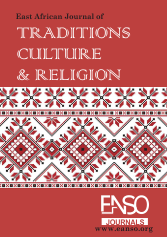The Nexus of Grievance, Pragmatism, and Ideology: Unpacking the Drivers of Women's Violent Extremism in Mandera County, Kenya
Abstract
The role of women in terrorist activities has grown, even with increased efforts to counter terrorism in Kenya. The common view of women as peacekeepers, victims, and homemakers has shaped Kenya's counter-terrorism strategies, which often overlook women as active participants. Although research on women and terrorism in Kenya is expanding, most studies do not fully explore the reasons why Muslim women join Al-Shabaab. The main goal of this study was to examine the reasons Muslim women engage in Al-Shabaab's violent extremism and thus guide policymakers on suitable and inclusive counter-terrorism. This research was guided by intersectionality theory, which was according to Davis (2015). This qualitative research employed a Mixed Methods Phenomenological Research (MMPR) design to analyse female agency and other factors related to their recruitment. The research took place in Mandera County and included 64 participants from four groups, with 16 respondents in each, and they include Muslim female returnees from Al-Shabaab, security agents and policymakers, civil society organisation leaders dealing with countering violent extremism programs, and female terror victims. Participants were chosen using specific and snowball sampling methods. Data was gathered through key informant interviews and focus group discussions. Interpretative phenomenological analysis /and Thematic analysis, supported by MAXQDA software, was used to analyse the data qualitatively. The findings show that women's involvement is not caused by a single factor. Instead, it results from grievances such as revenge and perceived injustice, along with socio-economic pressures and ideological manipulation. The results emphasise the importance of viewing women as individuals with personal agency and motivations, rather than just as victims. The study suggests a comprehensive approach that involves all segments of society and government, including women and youth, in peace, security, and prevention of violent extremism efforts. This study adds new insights into the reasons behind Muslim women's involvement in violent extremism and aims to help policymakers create more effective and inclusive counter-terrorism strategies.
Downloads
References
Ali, F.A. (2018). Understanding the role of gender relations in radicalization and recruiting Young Muslim Women in Higher Learning Institutions in Kenya, The African Review Vol. 45, No.1, 2018: 70-95. https://www.jstor.org/stable/45342136
Auchter, J. (2012). Gendering terror: Discourses of terrorism and writing woman-as-agent. International Feminist Journal of Politics, 14(1), 121-139.
Badurdeen, F. A. (2018). Women and recruitment in the Al-Shabaab network: Stories of women being recruited by women recruiters in the coastal region of Kenya. The African Review: A Journal of African Politics, Development and International Affairs, 19-48.
Bloom, M. (2007). Female suicide bombers: a global trend. Daedalus, 136(1), 94-102.
Bloom, M. (2011). “Bombshell: Women and Terrorism,” Gender Issues, 28(1 2): 5–13.
Brenner, L. (2024). Female Terrorism: A Scoping Review: Exploring the roles and motivations of women in far-right, and Islamist terrorism.
Campbell, S. K. (2015). Domestic Terrorism in the Canadian News Media: A Framing Analysis of Canadian-Connected Terrorism in 2013 Newspaper.
Cochrane, B., & Smith, D. (2021). The Push and Pull: Women and Violent Extremism. Academia Letters, 2.
Harmon, C., and Holmers Eber, P. (2014). “Women in Terrorist Undergrounds,” vCTX 4(4): 9.
Jacobsen, A. (2017). Pushes and pulls of radicalisation into violent Islamist extremism and prevention measures targeting these: Comparing men and women
Jacques, K., and Taylor, P. (2013). “Myths and Realities of Female Perpetrated Terrorism,” Law and Human Behaviour, 37(1): 9.
Nagarajan, C. (2016). “We Need to Dispel Some Myths About the Relationship Between Women and Violent Extremist Movements.” Ventures Africa.
Nzomo, M. (2018). Countering International Terrorism 21st Century Africa.
O’rourke, L. A. (2009). What's special about female suicide terrorism? Security Studies, 18(4), 681–718.
Salifu, U., Ndung’u, I., & Sigsworth, R. (2017). Violent extremism in Kenya—why women are a priority. Institute for Security Studies Monographs, 2017(197), 1–124.
Sjoberg, L. (2017). “Jihadi Brides and Female Volunteers: Reading the Islamic State War to see Gender Agency in Conflict Dynamics,” Conflict Management and Peace Science: Special Issue Gender Participation, Well Being and Representations in Political Violence, 1–16.
Sjoberg, L., & Gentry, C. E. (2007). (Your list: Sjoberg and Gentry, 2007.)
UNDP (United Nations Development Programme). (2017). Journey to Extremism in Africa: Drivers, Incentives and the Tipping Point for Recruitment.
Copyright (c) 2025 Hafsa Ali Ibrahim, Halkano Abdi Wario, Fatuma Ali

This work is licensed under a Creative Commons Attribution 4.0 International License.




























